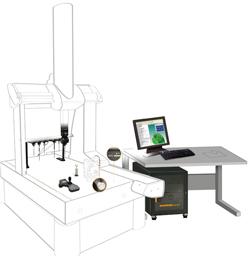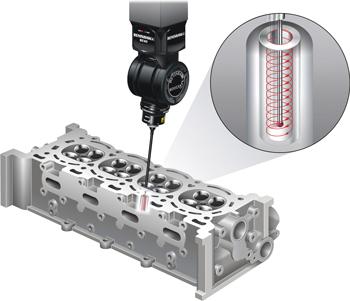- FMA
- The Fabricator
- FABTECH
- Canadian Metalworking
Going Retro
Adding life to an underutilized CMM with a retrofit can reduce a shop’s QA burden
- March 1, 2010
- Article
- Measurement
Coordinate measuring machines (CMMs) measure a part’s critical features and reports on size, position, and form.
And because most CMM structures are not subject to high levels of wear, these systems can remain in service for many years. However, software, control systems, and sensor technology can become outdated as the machine ages and as a company’s measurement needs change over time.
According to the experts, upgrading a CMM system can give it a new lease on life by increasing its measurement capability, speed, and functionality. By adding new software and controls, manufacturers can increase throughput and reduce operating costs at the same time.
For measuring form, a CMM can be upgraded to perform a scanning operation rather than measuring using discrete points. This allows complex forms to be measured more quickly and accurately than was previously possible.
The operational benefits for the end user come in the form of simpler and quicker data analysis and shorter lead-times. Five-axis scanning capability, for example, provides faster scanning speeds with no time spent indexing due to five-axis synchronized moves between features. Also, the flexibility of infinite angular positioning of the probe head reduces the need for changing styli and more time is spent measuring parts.
All of these benefits usually can be added to a piece of equipment that is being underutilized or not being used at all with a retrofit of the control system, software, and probing technology.
Not only will this eliminate QA department bottlenecks, it will provide faster feedback and free up CMM capacity to take on other measurement tasks.
In addition, new software capability can lead to higher-volume data analysis, better graphical reporting, as well as support for the latest in sensor technology.
The Retrofit Process
“When retrofitting a system it is our goal to take that old machine that is sitting in the corner not being used and bring it to a place where it is more productive than when it was new,” explained Dafydd Williams, general manager for Renishaw Canada.
As a company, Renishaw, which can provide everything needed for a complete CMM retrofit, recently launched this service in Canada following rollouts in England and also on mainland Europe.

Retrofitting a CMM can improve an underutilized machine and make it more productive than when it was new.
“We can supply the necessary controller, servo power amplifier, probing, joystick, encoding equipment, and software for a complete retrofit,” added Paul Gane, Renishaw Canada’s technical sales manager. “By using Inspection plus-plus Dimensional Measurement Equipment (I++ DME)-compatible software, we are also, in essence, futureproofing these machines. Because of this capability new software and sensors, for example, can be added easily to these retrofitted machines.”
I++ DME is a specification CMM manufacturers use to create a common machine interface. This protocol, which was started in 2001 by European automakers, ensures that all I++-compliant machines will perform correctly with any I++-compliant software.
“Not every machine is a candidate for a retrofit,” said Williams. “We must be able to start with a usable machine, and most importantly, a repeatable machine. To find this out we survey the condition of the machine. You can upgrade electronics and software, but that doesn’t mean that there won’t later be a problem with a motor.”
What should end users look for when deciding if their CMM is a retrofit candidate?
- Is the machine running?
- Are the drives and motors functioning?
- Is the machine repeatable?
- What is the condition of the wiring and air pipes.
An inaccurate machine usually indicates a mechanical problem. Also, the wiring and air pipes usually need to be replaced on older machines, according to Gane.
“There is not a lot we can do if the machine is not repeatable,” said Williams. “A repeatable machine we can make accurate, but no one can make a nonrepeatable machine accurate.”
Before any retrofitting takes place, a machine assessment and risk assessment need to be done.
“We always talk to the customer to find out what their plans are for the machine,” said Gane. “We need to understand what they want to measure now and also what they want to be able to measure five years from now.”
Retrofits are becoming more popular because of the number of second-hand machines on the market these days. However, there can be a risk associated with some of this used equipment.
“If you don’t know the history of the machine, it is hard to tell if it is a good candidate for retrofitting or not,” said Gane.

Retrofitting can upgrade metrology software and universal CMM controllers, as well as sensors and machine calibration.
Why Retrofit?
Retrofitting makes sense if measurement throughput can be increased and if the cost of owning a CMM can be reduced through time and labor savings.
“It can definitely be an economical method of getting the most from an underutilized or unused asset,” said Williams.
Also, as the size of the CMM increases, the value of retrofitting when compared to a new purchase also increases because the cost of replacement can be high.
“We definitely want the customer to be involved at every step,” said Williams. “If we can help them take a piece of unused equipment and make it usable again, then retrofitting definitely makes sense. If there are no advantages to be gained either technologically or fiscally, however, then a new purchase can be the way to go.”
For more information, visit www.renishaw.com/cmmretrofit.
subscribe now


Keep up to date with the latest news, events, and technology for all things metal from our pair of monthly magazines written specifically for Canadian manufacturers!
Start Your Free Subscription- Trending Articles
- Industry Events
MME Winnipeg
- April 30, 2024
- Winnipeg, ON Canada
CTMA Economic Uncertainty: Helping You Navigate Windsor Seminar
- April 30, 2024
- Windsor, ON Canada
CTMA Economic Uncertainty: Helping You Navigate Kitchener Seminar
- May 2, 2024
- Kitchener, ON Canada
Automate 2024
- May 6 - 9, 2024
- Chicago, IL
ANCA Open House
- May 7 - 8, 2024
- Wixom, MI















